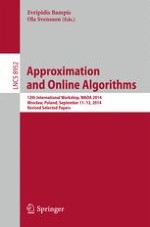This book constitutes the thoroughly refereed post-workshop proceedings of the 12th International Workshop on Approximation and Online Algorithms, WAOA 2014, held in Wrocław, Poland, in September 2014 as part of ALGO 2014.
The 22 revised full papers presented were carefully reviewed and selected from 49 submissions. They cover a wide range of topics such as coloring and partitioning, competitive analysis, network design, packing and covering, paradigms for design and analysis of approximation and online algorithms, randomization techniques, real-world applications, and scheduling problems.

